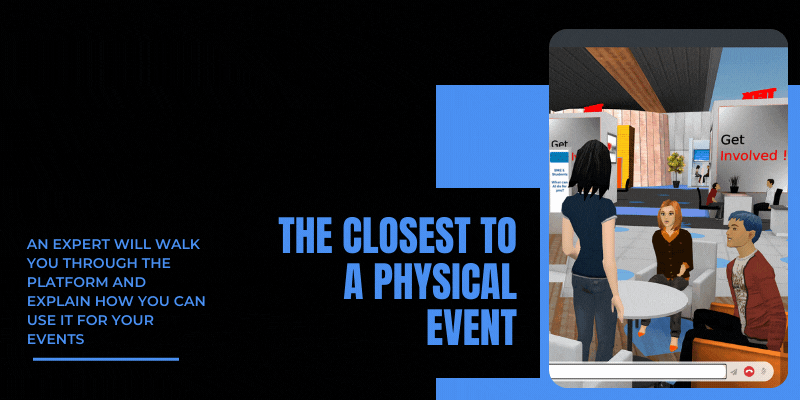Organizing a virtual event is not easy. You don’t have to book a venue, or accommodate your attendees, but your event still needs a wide variety of tasks to be done. That’s why we have created this Virtual Event Planning Checklist to make your life easier when hosting a virtual event.
Before the Virtual Event
❏ Identify the Why
All events have a goal, so the first thing you should do is to identify that goal. Ask yourself why you are hosting this event. The goal does not necessarily have to be unique, it can be anything: getting leads, engaging with your audience, improving your team building performance… Just find your event purpose.
❏ Decide the Length
It’s pretty basic but deciding the length of the event is key for determining the platform you may use, building the sponsor’s plan, and scheduling your event.
❏ Who is your Audience?
This one could be the most important. If you know your audience well you may be able to adapt the event to their taste, making the experience more engaging. If your attendees are from different time zones make sure to record the sessions.
❏ Budget
Virtual event’s budget is different than in-person events. You may consider different things such as which technology you are going to use. While technology represents an average of 25% of traditional events, in virtual events, it plays a key role. Expenses like venues, travel or decoration will be avoided if your event is fully digital.
❏ Know your Technology Needs
Depending on your needs you should consider different technological solutions. For example, a webinar is a much simpler option compared to a virtual fair. Figure out what interactions and activities you want to develop.
❏ Choose a Virtual Event Platform
Based on your needs choose a virtual event platform that can fulfill your requirements. Another key point to consider is the number of attendees you’ll be expecting. Keep in mind which integrations you may need for your event (Zoom, Slack, Teams…).
❏ Build an Event Content Plan
Once you know who your audience is and you have defined your goal, you should start building a content plan. Content, drives attendance engagement, and networking. The success of your event is largely influenced by your content plan, so take it seriously.
❏ Decide your Virtual Venue
You have already chosen the topic of your event so deciding the virtual venue should be easy. Is it a Zoom-based event? Then you can decide between hundreds of different virtual backgrounds. It’s totally fine if your event is more complex, platforms like MootUp offer lots of options (virtual classroom, virtual conference, virtual exhibition, etc).
❏ Create a Participants Guide
Since virtual events are quite new and some people are not very familiar with the platforms, having a participants guide will assist in making the experience more easy to follow and enjoyable for your audience. You may create different guides. You should include: one for the attendees showing how to interact with other participants, platform navigation, and any other relevant feature. Another useful option may be to include a speaker guide, which would include similar information to the attendee one, but with more specific information related to the chosen platform designed for event speakers.
❏ Find Virtual Event Sponsors
As in a physical event, sponsors play an important role. Different organizations may be interested in collaborating with your event. Building sponsorship packages which include sponsored sessions, ads, booth spaces, etc. is a great way to reach out to sponsors.
❏ Train Your Speakers
The ones speaking at your event are a relevant part of your event, so ensure that everything goes smoothly on that side. They should know how to interact with the platform in order to drive a good performance.
❏ Organically Promote your Event
ell your entire network about your event. Some free ways to do it consists of announcing it on your social media and your website. Third party calendar sites may be a good idea as well. Using SEO to push potential attendees to find your event when they are searching is something to be considered as well.
❏ Advertise Your Event
If promotion is part of your budget then you should use different advertising techniques. Using ad platforms, such as Google Ads or FB Ads, and promoted social media posts are just some of the wide variety of options.
❏ Follow up with your Attendees
Once your participants start signing up for the event you should continue communicating with them. You can send them some extra information of the event, any update that may occur and event reminders. All this will lead to higher engagement and attendance.
❏ Create an Event Landing Page
A customizable landing page with basic information from the event and a link to access the virtual event platform will make things a lot easier for your audience come event time.
During the Event
❏ Make sure everything is working well (A few hours before the event)
Doing a check up with the platform technology provider is important for two reasons: 1) you may detect issues that need to be fixed before the event and 2) you’ll learn interesting things that will make your event run smoothly.
❏ Have an Emergency Plan
Any unexpected issue will turn into something you may be able to deal with by having an emergency plan for your event. Everything should go fine, but you better be ready just in case.
❏ Capture Attendee Data
The virtual event technology used may have some analytical solution integrated. Attendee data helps you identify your leads and clients better, and also improves your next event based on the engagement from the sessions and much more.
❏ Take Photos and Videos
Don’t forget that this is like a physical event and you probably want to show your followers what’s going on in your events. Recording the sessions is helpful if you want to reuse all that material in the future.
❏ Goody Bag
Virtual event goody bags are also a thing. As in a physical one, a gift bag will improve brand awareness and engagement. This can be from a physical gift that you’ll ship to your audience to a digital version sent by email, just try to be creative.
❏ Keep an eye on Questions and Comments
During the event a lot of questions and comments will be happening. Some of them will be related to the technology and others to the event itself. Attending those queries will give an extra boost of engagement and professionality.
❏ Promote Networking
Networking is one of the principal reasons people attend events. So encourage one-on-one appointments and breakout sessions to facilitate the networking. Some virtual event platforms like MootUp have solutions based on interaction like private rooms.
❏ Make sure to have direct communication with Technical Support
Technical support communication might be part of the emergency plan we were talking about earlier. In case of an emergency, their help will make things easier.
Post-Event
❏ Ask your audience if they liked it
Sending a post-event feedback survey will allow you to measure the success of your event.
❏ Analyze your Data
Checking out the gathered data will help you realize if your event reached its goals as well as identify what may need to be improved upon in the future.
❏ Present the Results of the event to Stakeholders
Your sponsors and other stakeholders might be interested in knowing how your event went. Giving them specific results will make that feedback more credible and complete.
❏ Share Information about your Event
Take advantage of all the photos, videos, and articles from the event. This will engage your audience and attract future attendees.
❏ Send a Thank You email to the attendees
Your audience will appreciate it and it’s a perfect way to ask your audience for feedback.
❏ Take what you learned for the next event
There’s always something that could be improved. Try to figure out what it is and take action for your next event.

